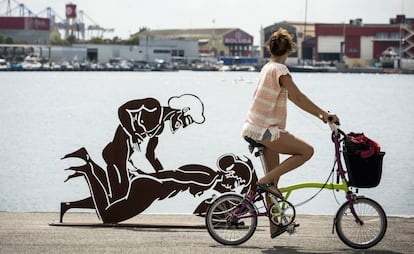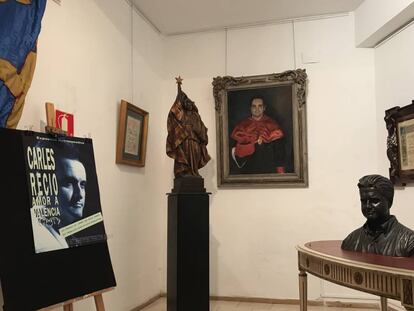Why sculptures based on 2,600-year-old Greek ceramics are shocking Valencia
An outdoor exhibition by Antoni Miró is causing a stir in the city, with some parents saying the erotic artworks should not be visible to children

Spanish artist Antoni Miró is unfazed by the controversy. A dozen of his sculptures have been installed outdoors in Valencia’s marina, but not everyone is happy about the work, which is based on classic erotic iconography. Many parents argue that the pieces, which show people performing a range of sexual acts, should not been seen by children.
It’s more meditative and spiritual than pornographic
Curator Fernando Castro
Miró disagrees: “The sculptures are inspired by drawings of popular Greek ceramics. These were not hidden but rather used in people’s everyday lives 2,600 years ago. In some ways, they were more advanced than we are now.”
The sculptures, made from Corten steel a decade ago, are part of an exhibition set to open on September 25. It will be Miró’s largest show to date. The 74-year-old painter and sculptor had been shunned while the conservative Popular Party (PP) was governing the region. But with the new Socialist premier Ximo Puig in power, he and other artists are being offered an olive branch.

The exhibition will open in a cultural center created in what was once the base for Alinghi, the Swiss competitive sailing team that won the America’s Cup in 2007. The voluminous space, which features 1,900 square meters and 15-meter tall ceilings, will display 150 works by Miró, whose art mixes pop culture with social protest.
But it is the erotic work outside the building that is causing a stir. In an article published in the local daily Las Provincias, a group of parents protested against the sculptures’ installation in a public space where they could be seen by children.
The artist, however, argues that “children too young to understand them are not interested. And those who are old enough are going to see it here or somewhere else because they are interested, no matter how hard anyone tries to stop them.”
On why the marina was chosen, curator Fernando Castro explains: “The promenade seemed like a good location because the sculptures are cut-outs and you can see through them. Classical era eroticism depicts desire, moral geometry and nudity as a way of harmonizing with nature. On the other hand, it’s more meditative and spiritual than pornographic. I’m surprised that it’s created controversy.”
Children too young to understand them are not interested
Artist Antoni Miró
The authorities that oversee the marina – regional, local and national – have left the matter in Castro’s hands, arguing it is an artistic matter. So far, the only politician to have commented on the debate has been the mayor of Valencia, Joan Ribó of the leftist Compromís party. “We think it could be questionable for some, but for others it’s totally normalized. In many museums in Italy and other places, you can find similar figures and there’s no issue.”
Disruption
The regional government of Valencia came up with the idea of holding a large-scale exhibition of Miró’s work. It wanted to organize it at the Valencia Institute of Modern Art (IVAM) but the gallery’s agenda was already closed. After ruling out different spaces, it settled on the new cultural space in the marina.
Curator Castro believes the real controversy will be over the works located inside – not outside – the space.
“There are political flags, challenging messages, police charges … Inside there is a tension that is not about desire or pleasure but rather the modern world that screams and is outraged. Viewers are not going to agree with all the political choices. But an artist is not a parliament, they are not a space that looks for consensus. Artists instead look to create disruption.”
English version by Melissa Kitson.
Tu suscripción se está usando en otro dispositivo
¿Quieres añadir otro usuario a tu suscripción?
Si continúas leyendo en este dispositivo, no se podrá leer en el otro.
FlechaTu suscripción se está usando en otro dispositivo y solo puedes acceder a EL PAÍS desde un dispositivo a la vez.
Si quieres compartir tu cuenta, cambia tu suscripción a la modalidad Premium, así podrás añadir otro usuario. Cada uno accederá con su propia cuenta de email, lo que os permitirá personalizar vuestra experiencia en EL PAÍS.
¿Tienes una suscripción de empresa? Accede aquí para contratar más cuentas.
En el caso de no saber quién está usando tu cuenta, te recomendamos cambiar tu contraseña aquí.
Si decides continuar compartiendo tu cuenta, este mensaje se mostrará en tu dispositivo y en el de la otra persona que está usando tu cuenta de forma indefinida, afectando a tu experiencia de lectura. Puedes consultar aquí los términos y condiciones de la suscripción digital.
More information
Archived In
Últimas noticias
Reinhard Genzel, Nobel laureate in physics: ‘One-minute videos will never give you the truth’
Pinochet’s victims grapple with José Antonio Kast’s rise in Chile
How Japan is trying to avert ‘digital defeat’
The complicated life of Francesca Albanese: A rising figure in Italy but barred from every bank by Trump’s sanctions
Most viewed
- Pablo Escobar’s hippos: A serious environmental problem, 40 years on
- Why we lost the habit of sleeping in two segments and how that changed our sense of time
- Charles Dubouloz, mountaineering star, retires at 36 with a farewell tour inspired by Walter Bonatti
- Trump’s obsession with putting his name on everything is unprecedented in the United States
- The Florida Keys tourist paradise is besieged by immigration agents: ‘We’ve never seen anything like this’











































